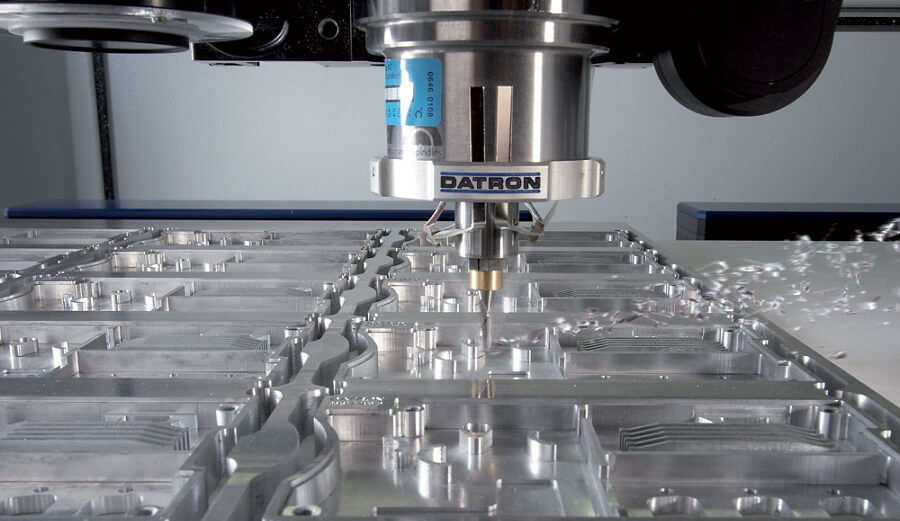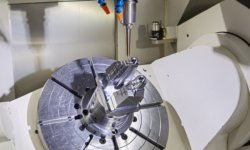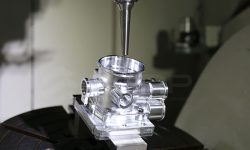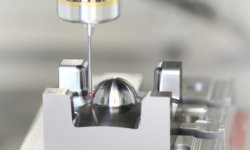Companies that design and manufacture plastic or metal parts will often require rapid machining services at some point during product development.
This article looks at the ins and outs of the manufacturing process and why it is so important.
What is rapid machining?
Rapid machining is the machining of parts and prototypes with an explicit focus on reducing the time taken to make the parts. It usually involves CNC machining (including milling, turning, etc.) but may also include manual machining for simple parts.
Machining can be expedited in various ways. Depending on the customer’s requirements, rapid machining may involve increased use of high-torque machines and roughing techniques in order to speed up material removal. It may also involve easy-to-machine materials like aluminum alloys over materials that require more time to machine.
Although not mutually exclusive, rapid machining can be seen as a counterpoint to precision machining, which prioritizes accuracy and detail over speed.
Pros and cons
Rapid machining is an essential tool for rapid prototyping, product development, low-volume manufacturing and custom parts. However, it is not suitable for all manufacturing jobs.
These are some of the advantages and disadvantages of rapid machining:
Pros
- The fastest way to produce parts with CNC machining equipment
- Iterates prototypes quickly to speed up product development
- Easy to fabricate multiple versions of a part for mechanical testing etc.
- Faster time-to-market
- Makes stronger parts compared to other high-speed processes like 3D printing
- No minimum order quantity
- No tooling or startup costs
- Compatible with a range of metals and plastics
- Range of surface finishing options
- Scalable since CNC machining is suitable for production at a later time
Cons
- Lower quality than precision machining
- Less geometrical freedom than 3D printing
- Slower than molding processes for high-volume orders (100+)
How rapid machining speeds up product development and reduces time-to-market?
For decades, rapid machining has been a go-to process for product designers looking to move their product from one stage of development to the next.
Rapid machined prototypes can be used for testing and evaluation, and it is easy to fabricate multiple iterations of a design for comparative analysis. Some rapid machined parts are even suitable for end-use.
It’s easy to see why designers engineers keep turning to rapid machining for instant parts. In this day and age, most parts are designed using CAD software, and the exported design files can be processed by CNC machines with minimal preparation. This closes the time gap between finishing a prototype design and receiving the finished part.
And the process is often repeated several times. If product designers are ordering rapid machined prototypes for testing, they may need to tweak their designs and build several more iterations before the part is ready for production.
Rapid machining also provides prototypes that are similar to end-use parts in terms of quality, mechanical performance, and appearance. Other prototyping processes like 3D printing and manual assembly have their own unique advantages, but if a part will eventually be manufactured with a CNC machine, a machined prototype will obviously be more representative of the machined final part.
Committing to a consistent manufacturing process provides obvious time advantages. If a 3D printed prototype has to be redesigned into a machinable end-use part, a whole new stage of design is added to the overall process. No such stage is required for rapid machined prototypes.
A product development workflow using rapid machining may therefore go something along these lines:
- Concept
- CAD part design
- Early-stage conceptual prototype(s) via rapid machining
- Testing and evaluation
- Working prototype(s) via rapid machining
- Mechanical testing and evaluation
- Pre-production prototype(s) via precision machining
- Presentation, marketing, etc.
- Production
- Distribution
Ultimately, faster product development and shorter time-to-market give companies a competitive edge and leads to a greater chance of market success.
What level of quality should I expect from rapid machining?
Rapid machining is most frequently used as a prototyping process. As such, customers should remember that there are other options (precision machining, for example) that may be better suited to high-detail parts that demand tight tolerances. As its name suggests, rapid machining prioritizes speed over other factors.
That being said, rapid machining can produce professional-grade parts and prototypes to a very high standard.
Ordering parts from a rapid machining specialist ultimately allows the customer to stipulate the level of quality of required, by specifying tolerances and choosing a material of suitable quality and price.
Loose tolerances, simple designs and the use of high-machinability materials allow machinists to make the parts faster, giving a lower priority to part quality. During prototyping and product development, this is usually a sensible route to take, as professional machinists are still able to make good quality parts while working quickly.
How 3ERP achieves high speeds during rapid machining
Opting for rapid machining is only worthwhile if the machining company actually knows how to get things done efficiently — otherwise, the customer ends up sacrificing quality and getting none of the benefits.
3ERP is a specialist in rapid machining and has perfected several techniques for getting high-quality parts done fast.
Here are some of the reasons why we machine faster than the competition:
It’s in our nature: 3ERP was established as a rapid prototyping company, and our entire setup — from customer interactions to the factory floor — is optimized for fast turnarounds, whatever the project.
We know which machines to use: Different projects demand different equipment, and rapid machining has its own particular set of machine requirements. For large parts that require large amounts of material removed, we might employ a high-torque 20 kW machine with a 12,000 rpm spindle; for detailed surface finishes, we might use a lower-torque machine with a 24,000 rpm spindle.
We know how to cut quickly: Rapid machining isn’t achieved by just lopping off as much material as possible at once: sometimes it’s faster to make multiple shallow cuts instead of one deep cut. Fast machining involves choosing the right cutting tool and making the right cuts, in addition to using high-end CAM software to determine the most efficient tool paths for a job.
Tight deadlines: Rapid machining or 3D printing?
3D printing has changed the prototyping landscape by allowing users to fabricate one-off parts in a matter of hours. 3D printers can even be operated in offices, reducing the need for traditional factories and machine shops.
Because of the speed and simplicity of 3D printing, some product developers will automatically turn to additive manufacturing over subtractive processes like rapid CNC machining when time is of the essence.
But is 3D printing always the best option for fast-turnaround parts?
For in-house prototyping, there is probably no better rapid solution than 3D printing, since 3D printers require minimal expertise to operate and can print parts in hours. However, a professional rapid machining service may be faster and deliver better results than a comparable 3D printing service.
There are some obvious parallels between rapid machining and 3D printing. Both use digital designs that are turned into G-code, and both are all-in-one solutions that require no tooling or separate machinery.
When choosing between rapid machining and 3D printing, bear the following factors in mind:
- Some parts are faster to print; others are faster to machine
- Even if 3D printing is faster, it may take a long time to rework a 3D printed prototype into a machined final part
- Both metals and plastic can be machined with the same machining equipment; 3D printers only print one or the other
- Machined prototypes are usually closer to the final part than printed prototypes
3ERP is a specialist in rapid machining. Request a free quote today on your next rapid machining project.







